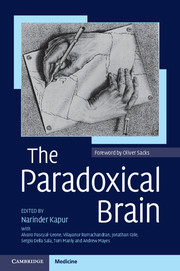Book contents
- Frontmatter
- Contents
- Acknowledgements
- Preface
- Foreword
- Author affiliations
- Abbreviations
- 1 The paradoxical nature of nature
- 2 Paradoxical effects of sensory loss
- 3 Paradoxical functional facilitation and recovery in neurological and psychiatric conditions
- 4 Paradoxes in neurorehabilitation
- 5 The paradoxical self
- 6 Paradoxical psychological functioning in early child development
- 7 Cognitive ageing: a positive perspective
- 8 Paradoxes of learning and memory
- 9 The paradox of human expertise: why experts get it wrong
- 10 Paradoxes in Parkinson's disease and other movement disorders
- 11 Paradoxical phenomena in epilepsy
- 12 Paradoxical creativity and adjustment in neurological conditions
- 13 Paradoxical functional facilitation with noninvasive brain stimulation
- 14 Unexpected benefits of allergies and cigarette smoking: two examples of paradox in neuroepidemiology
- 15 The paradox of autism: why does disability sometimes give rise to talent?
- 16 Paradoxes in creativity and psychiatric conditions
- 17 The paradox of psychosurgery to treat mental disorders
- 18 The paradox of electroconvulsive therapy
- 19 Paradoxes of comparative cognition
- 20 Paradoxical phenomena in brain plasticity
- 21 Immature neurons in the adult brain. Breaking all the rules
- 22 The paradoxical hippocampus: when forgetting helps learning
- 23 Paradoxical effects of drugs on cognitive function: the neuropsychopharmacology of the dopamine and other neurotransmitter systems
- 24 The paradoxical brain – so what?
- Index
- References
16 - Paradoxes in creativity and psychiatric conditions
Published online by Cambridge University Press: 05 December 2011
- Frontmatter
- Contents
- Acknowledgements
- Preface
- Foreword
- Author affiliations
- Abbreviations
- 1 The paradoxical nature of nature
- 2 Paradoxical effects of sensory loss
- 3 Paradoxical functional facilitation and recovery in neurological and psychiatric conditions
- 4 Paradoxes in neurorehabilitation
- 5 The paradoxical self
- 6 Paradoxical psychological functioning in early child development
- 7 Cognitive ageing: a positive perspective
- 8 Paradoxes of learning and memory
- 9 The paradox of human expertise: why experts get it wrong
- 10 Paradoxes in Parkinson's disease and other movement disorders
- 11 Paradoxical phenomena in epilepsy
- 12 Paradoxical creativity and adjustment in neurological conditions
- 13 Paradoxical functional facilitation with noninvasive brain stimulation
- 14 Unexpected benefits of allergies and cigarette smoking: two examples of paradox in neuroepidemiology
- 15 The paradox of autism: why does disability sometimes give rise to talent?
- 16 Paradoxes in creativity and psychiatric conditions
- 17 The paradox of psychosurgery to treat mental disorders
- 18 The paradox of electroconvulsive therapy
- 19 Paradoxes of comparative cognition
- 20 Paradoxical phenomena in brain plasticity
- 21 Immature neurons in the adult brain. Breaking all the rules
- 22 The paradoxical hippocampus: when forgetting helps learning
- 23 Paradoxical effects of drugs on cognitive function: the neuropsychopharmacology of the dopamine and other neurotransmitter systems
- 24 The paradoxical brain – so what?
- Index
- References
Summary
Summary
The question of whether or not mental disorder is the price humanity pays for exceptional creativity has been debated since classical times. Modern research methodologies have been adding increasingly robust empirical data to inform this debate. Studies of accomplished individuals have found that exceptionally creative writers report more affective illness. Population-based studies have found an excess of extremely high scholastic achievement amongst people with bipolar affective disorder, but not schizophrenia. These findings have been interpreted as evidence that people with affective disorders are a likely source of society's most exceptional ideas and work. Widespread stigmatization of mental health problems would be profoundly challenged by evidence that social progress relies on individuals with mental illness. However, such a romantic ideal often tempts researchers to over-interpret findings in this area. Research in this area faces many methodological difficulties, and despite decades of research, there is little that can be confidently claimed regarding putative mechanisms that could explain how mental disorder translates into creative processes, or vice versa. This chapter does not claim to put these ancient debates to rest, but it does provide an account of the current research that has explored these seemingly paradoxical associations between psychiatric disorders and creativity.
Introduction
Society throughout the ages has been drawn towards the archetype of the mad genius. Major figures from history have exemplified putative associations between exceptional creativity and mental disorder (Andreasen,1987; Jamison, 1989, 1993; Jamison and Goodwin, 2007; MacCabe, 2010; MacCabe et al. 2009).
- Type
- Chapter
- Information
- The Paradoxical Brain , pp. 289 - 300Publisher: Cambridge University PressPrint publication year: 2011
References
- 3
- Cited by



